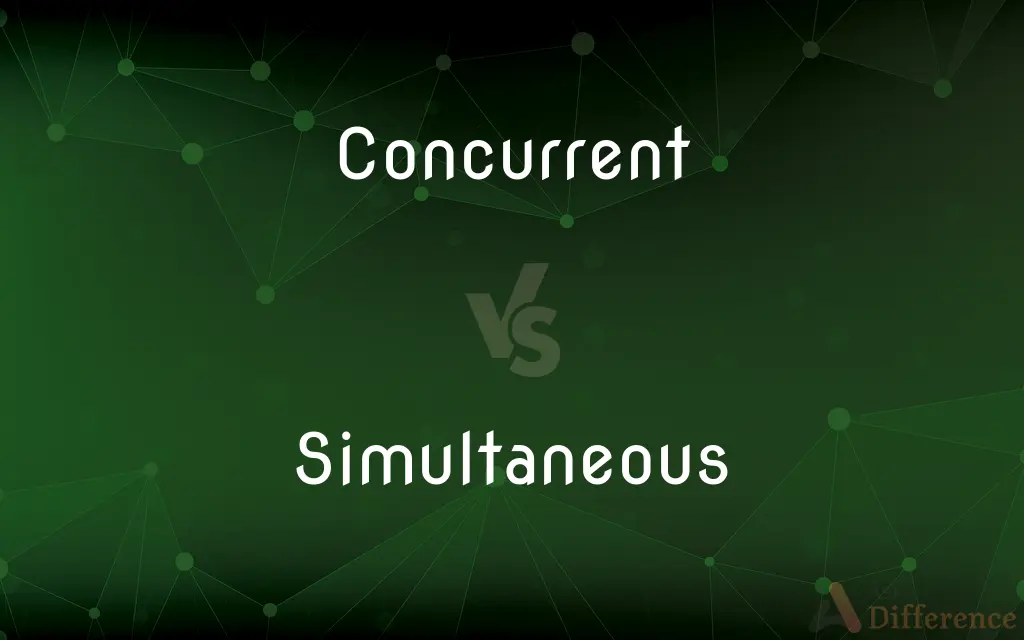Concurrent vs. Simultaneous — What's the Difference?
By Maham Liaqat & Urooj Arif — Updated on March 15, 2024
Concurrent events or processes run parallel over a period, potentially overlapping in time, while simultaneous events or actions occur exactly at the same moment.

Difference Between Concurrent and Simultaneous
Table of Contents
ADVERTISEMENT
Key Differences
Concurrent events or activities share a timeframe and can overlap, but they do not necessarily start or finish at the exact same moment. This term often describes things that happen or exist together in a way that they may interact or intersect. Simultaneous, on the other hand, is more specific in its requirement that events or actions occur at precisely the same moment in time.
Concurrent courses at a university may occur within the same semester, allowing a student to attend both, even if their schedules do not precisely align every day. Simultaneity implies a stricter coordination of timing, such as two clocks striking noon at the exact same instant. This term is particularly used when the precision of timing is crucial or noteworthy, emphasizing the synchronicity of occurrences.
While both concepts involve the occurrence of multiple events or actions in relation to time, the key difference lies in the precision with which these events align. Concurrent activities might overlap or run alongside each other within a broader timeframe, offering flexibility and interaction. Simultaneous activities demand exact timing, highlighting their occurrence at a single, specific point in time.
The distinction is not just semantic but practical, affecting planning, coordination, and interpretation in various contexts. In computing, for example, concurrent programming involves tasks that make progress together but not necessarily at the same instant, while simultaneous operations would require exact timing alignment, as seen in synchronized systems.
Understanding whether events are concurrent or simultaneous can significantly impact logistical planning, legal interpretations, and technological designs, among other fields, underscoring the importance of temporal relationships in diverse contexts.
ADVERTISEMENT
Comparison Chart
Timing
Overlap within a period, not precisely aligned
Occur at exactly the same moment
Flexibility
May interact or intersect, offering flexibility
Requires strict coordination of timing
Application
Broad, including courses, tasks, or legal processes
Specific, emphasizing precision in timing
Example
Courses offered during the same semester
Two clocks striking noon simultaneously
Key Aspect
Overlapping timeframe
Exact moment of occurrence
Compare with Definitions
Concurrent
Involving overlapping periods without precise timing alignment.
She worked on two concurrent projects at the office.
Simultaneous
Emphasizes precision and synchronicity.
The dancers moved in perfect, simultaneous harmony.
Concurrent
Occurring or existing simultaneously or side by side.
The two TV shows air on concurrent timeslots on different channels.
Simultaneous
Denotes a single, specific point in time.
Witnesses reported hearing simultaneous claps of thunder from the storm.
Concurrent
Allows for interaction or intersection among events or tasks.
The conference scheduled concurrent sessions in different rooms.
Simultaneous
Happening, existing, or done at the exact same time.
The fireworks displays in multiple cities were synchronized to start simultaneously.
Concurrent
Often related to broader timeframes or durations.
The artist held concurrent exhibitions in two cities.
Simultaneous
Requires exact timing for events or actions.
The experiment required simultaneous measurements from all sensors.
Concurrent
Used to describe parallel processes or events.
The system runs multiple concurrent operations to optimize performance.
Simultaneous
Applied when timing coordination is crucial.
The software update was deployed simultaneously across all devices.
Concurrent
Happening, existing, or done at the same time as something else
Dealing with concurrent crises.
Simultaneous
Happening, existing, or done at the same time.
Concurrent
Meeting or tending to meet at the same point; convergent
Concurrent lines.
Simultaneous
(Mathematics) Containing variables for which there are values that can satisfy all the equations
Simultaneous equations.
Concurrent
Being in accordance; harmonious
Are these decisions concurrent with university policy?.
Simultaneous
Happening at the same moment.
Concurrent
Happening at the same time; simultaneous.
Simultaneous
To be solved for the same values of variables.
Concurrent
Belonging to the same period; contemporary.
Simultaneous
Existing, happening, or done, at the same time; as, simultaneous events.
Concurrent
Acting in conjunction; agreeing in the same act or opinion; contributing to the same event or effect.
Simultaneous
Occurring or operating at the same time;
A series of coincident events
Concurrent
Joint and equal in authority; taking cognizance of similar questions; operating on the same objects.
The concurrent jurisdiction of courts
Concurrent
(geometry) Meeting in one point.
Concurrent
Running alongside one another on parallel courses; moving together in space.
Concurrent
Designed to run independently, rather than sequentially, using various mechanisms, such as threads, event loops or time-slicing.
Concurrent
One who, or that which, concurs; a joint or contributory cause.
Concurrent
One pursuing the same course, or seeking the same objects; hence, a rival; an opponent.
Concurrent
One of the supernumerary days of the year over fifty-two complete weeks; so called because they concur with the solar cycle, the course of which they follow.
Concurrent
One who accompanies a sheriff's officer as witness.
Concurrent
Acting in conjunction; agreeing in the same act or opinion; contributing to the same event or effect; coöperating.
I join with these laws the personal presence of the kings' son, as a concurrent cause of this reformation.
The concurrent testimony of antiquity.
Concurrent
Conjoined; associate; concomitant; existing or happening at the same time.
There is no difference the concurrent echo and the iterant but the quickness or slowness of the return.
Changes . . . concurrent with the visual changes in the eye.
Concurrent
Joint and equal in authority; taking cognizance of similar questions; operating on the same objects; as, the concurrent jurisdiction of courts.
Concurrent
Meeting in one point.
Concurrent
One who, or that which, concurs; a joint or contributory cause.
To all affairs of importance there are three necessary concurrents . . . time, industry, and faculties.
Concurrent
One pursuing the same course, or seeking the same objects; hence, a rival; an opponent.
Menander . . . had no concurrent in his time that came near unto him.
Concurrent
One of the supernumerary days of the year over fifty-two complete weeks; - so called because they concur with the solar cycle, the course of which they follow.
Concurrent
Occurring or operating at the same time;
A series of coincident events
Common Curiosities
Are concurrent tasks dependent on each other?
Concurrent tasks may run independently or dependently, with potential interactions or intersections, but they do not require the strict timing alignment of simultaneous tasks.
Can events be both concurrent and simultaneous?
While concurrent events share a period and may overlap, simultaneous events occur at precisely the same moment. Events typically fall into one category based on the context of timing and coordination.
Why is the distinction important in computing?
In computing, understanding whether processes are concurrent or simultaneous affects how tasks are programmed, executed, and synchronized, impacting system efficiency and performance.
What role do concurrent and simultaneous events play in multitasking?
In multitasking, concurrent events allow for the handling of multiple tasks within the same period, leveraging overlaps for efficiency, while simultaneous tasks require executing several actions at precisely the same moment, demanding higher coordination and potentially increasing complexity in task management.
How does legal interpretation differentiate between concurrent and simultaneous actions?
Legally, concurrent actions, such as sentences or contracts, can overlap in time and effect, while simultaneous actions would occur at exactly the same moment, potentially affecting interpretations of intent or causality.
How can understanding these terms benefit project management?
In project management, distinguishing between concurrent and simultaneous tasks helps in scheduling, resource allocation, and ensuring that critical tasks are completed efficiently and effectively.
Can a live event be both concurrent and simultaneous with an online stream?
A live event and its online stream are concurrent in that they occur during the same timeframe, providing an overlapping experience. They can be simultaneous if the live content and stream are experienced in real-time, with no delay between the live action and its digital broadcast, emphasizing the importance of synchronization in live streaming technology.
In what ways do concurrent and simultaneous learning models differ in education?
Concurrent learning models might involve students engaging with different educational materials or courses over the same semester, allowing for flexible learning paths. Simultaneous learning requires learners to engage in activities or lessons at the exact same time, such as in synchronized online classes, highlighting the role of real-time interaction and coordination in educational settings.
How do concurrent and simultaneous processes affect network operations?
In network operations, concurrent processes can enhance throughput by allowing multiple data transfers or communications to overlap in time, optimizing resource use. Simultaneous processes, however, involve exact timing for operations like data synchronization across systems, requiring precise coordination to ensure data integrity and consistency.
How do the concepts of concurrent and simultaneous impact performance in athletics?
In athletics, concurrent training sessions might overlap in objectives, such as combining strength and endurance training in a single period, allowing for versatile skill development. Simultaneous actions, such as team members executing a play at a precise moment, demand exact coordination and timing, directly impacting the outcome of competitive sports and performances.
Share Your Discovery

Previous Comparison
Out vs. In
Next Comparison
Godmother vs. MotherAuthor Spotlight
Written by
Maham LiaqatCo-written by
Urooj ArifUrooj is a skilled content writer at Ask Difference, known for her exceptional ability to simplify complex topics into engaging and informative content. With a passion for research and a flair for clear, concise writing, she consistently delivers articles that resonate with our diverse audience.














































